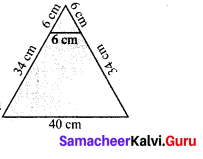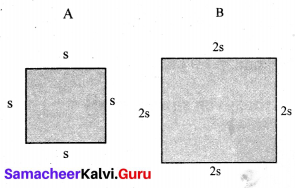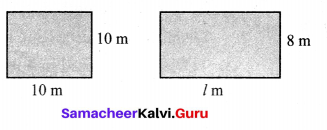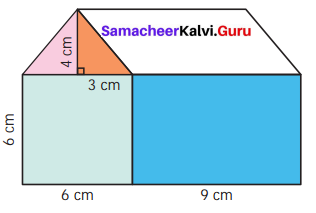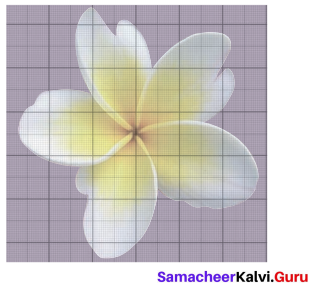Samacheer Kalvi 6th Maths Solutions Term 2 Chapter 3 Bill, Profit and Loss Ex 3.2
You can Download Samacheer Kalvi 6th Maths Book Solutions Guide Pdf, Tamilnadu State Board help you to revise the complete Syllabus and score more marks in your examinations.
![]()
Tamilnadu Samacheer Kalvi 6th Maths Solutions Term 2 Chapter 3 Bill, Profit and Loss Ex 3.2
Miscellaneous Practice Problems
Question 1.
A shopkeeper buys three articles for ₹ 325, ₹ 450, and ₹ 510. He is able to sell them for ₹ 350, ₹ 425, and ₹ 525 respectively. Find the gain or loss to the shopkeeper on the whole.
Solution:
Total cost price of the three articles = Rs 325 + Rs 450 + Rs 510 = Rs 1285
Total selling price of the three articles = Rs 350 + Rs 425 + Rs 525 = Rs 1,300
CP < SP
Profit = SP – CP
= Rs 1,300 – Rs 1,285
= Rs 15
Question 2.
A stationery shop owner bought a scientific calculator for Rs 750. He had put a battery worth Rs 100 in it. He had spent Rs 50 for its outer pouch. He was able to sell it for Rs 850. Find his profit or loss.
Solution:
CP = Rs 750 + Rs 100 + Rs 50
= Rs 900
SP = Rs 850
SP < CP
Loss = CP – SP
= Rs 900 – Rs 850
= Rs 50
Question 3.
Nathan paid ₹ 800 and bought 10 bottles of honey from a village vendor. He sold them in a city for ₹ 100 per bottle. Find his profit or loss.
Solution:
Cost of 10 bottles of honey = Rs 800
CP = Rs 800
Selling price of 10 bottles = Rs 100 × 10
SP = Rs 1000
SP > CP
Profit = SP – CP
= Rs 1,000 – Rs 800
= Rs 200
Question 4.
A man bought 400 metre of cloth for Rs 60,000 and sold it at the rate of Rs 400 per metre. Find his profit or loss.
Solution:
Cost of 400 m of cloth = Rs 60,000
CP = Rs 60,000
Selling price of 400 m of cloth = 400 × Rs 400
SP = Rs 1,60,000
SP > CP
Profit = SP – CP
= Rs 1,60,000 – Rs 60,000
= Rs. 1,00,000
![]()
Challenge Problems
Question 5.
A fruit seller bought 2 dozen bananas at ₹ 20 a dozen and sold them at ₹ 3 per banana. Find his gain or loss.
Solution:
Cost price of 2 dozen bananas = 2 × Rs 20
CP = Rs. 40
2 dozen = 24 bananas
Selling price of 2 dozen bananas = Rs 3 × 24
SP = Rs 72
SP > CP
Profit = SP – CP
= Rs 72 – Rs 40
= Rs 32
Question 6.
A store purchased pens at Rs 216 per dozen. He paid Rs 58 for conveyance and sold the pens at the discount of Rs 2 per pen and made an overall profit of Rs 50. Find the M.P. of each pen.
Solution:
Cost of 1 dozen pens = Rs 216 + Rs 58
CP = Rs 274
Discount for each pen = Rs 2
Overall profit = Rs 50
Total discount for 12 pens = Rs 2 × 12
= Rs 24
Selling price of 12 pens = Mp – Discount
SP = Mp – Rs 24
Profit = SP – CP
Rs 50 = Mp – Rs 24 – Rs 274
MP = Rs 50 + Rs 24 + Rs 274
= Rs 348 (1 dozen)
MP of each pen = Rs 348 / 12
= Rs 174/6
= Rs 29
Question 7.
A vegetable vendor buys 10 kg of tomatoes per day at ₹ 10 per kg, for the first three days of a weak. 1 kg of tomatoes got smashed on every day for those 3 days. For the remaining 4 days of the week, he buys 15 kg of tomatoes daily at ₹ 8 per kg. If for the entire week he sells tomatoes at ₹ 20 per kg, then find his profit or loss for the week.
Solution:
First 3 days
Tomatoes purchased for one day = 10 Kg
Tomatoes purchased for 3 days = 3 × 10 Kg = 30 Kg
The cost price of purchasing 30 Kg of Tomatoes = Rs 10 × 30 = Rs 300
Next four days
Tomatoes purchased for one day = 15 Kg
Tomatoes purchased for four days = 4 × 15 Kg = 60 Kg
Cost price of purchasing 60 Kg of Tomatoes = Rs 8 × 60 = Rs 480
Total cost price = Rs 300 + Rs 480 = Rs 780
Tomatoes smashed on the first 3 days = 3 x 1 Kg = 3 Kg
Remaining Tomatoes on the first 3 days = (30 – 3) Kg = 27 Kg
Weight of the remaining tomatoes in that week = (27 + 60) Kg = 87 Kg
The selling price of 1 Kg of Tomato = Rs 20
The selling price of 87 Kg of Tomatoes = Rs 20 × 87
SP = Rs 1,740
SP > CP
Profit = SP – CP = Rs 1,740 – Rs 780 = Rs 960
Question 8.
An electrician buys a used T.V. for Rs 12,000 and a used Fridge for Rs 11,000. After spending Rs 1,000 on repairing the T.V. and Rs 1500 on painting the Fridge, he fixes up the M.P. of T.V. as Rs 15,000 and that of Fridge as Rs 15,500. If he gives Rs 1000 discount on each find his profit or loss.
Solution:
Total cost price of TV and Fridge = Rs 12,000 + Rs 11,000 + Rs 1,000 + Rs 1,500 = Rs 25,500
Selling price of TV = MP – Discount = Rs 15,000 – Rs 1,000 = Rs 14,000
Selling price of Fridge = MP – Discount = Rs 15,500 – Rs 1,000 = Rs 14,500
Total Selling price of TV and Fridge = Rs 14,000 + Rs 14,500 = Rs 28,500
SP > CP
Profit = SP – CP = Rs 28,500 – Rs 25,500 = Rs 3,000
![]()
